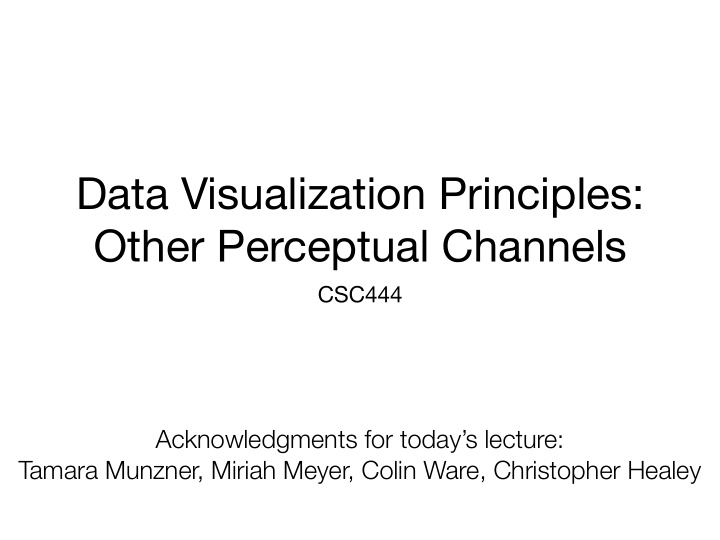



Data Visualization Principles: Other Perceptual Channels CSC444 Acknowledgments for today’s lecture: Tamara Munzner, Miriah Meyer, Colin Ware, Christopher Healey
PREATTENTIVENESS, OR “VISUAL POP-OUT”
ORIENTATION Christopher Healey, http://www.csc.ncsu.edu/faculty/healey/PP/index.html
WIDTH/LENGTH Christopher Healey, http://www.csc.ncsu.edu/faculty/healey/PP/index.html
SIZE Christopher Healey, http://www.csc.ncsu.edu/faculty/healey/PP/index.html
Mixing is not always pre- attentive
Preattentiveness is only simple to understand when considering one channel at a time.
VISUAL CHANNELS YOU SHOULD BE CAREFUL WITH, EVEN IN ISOLATION
3D is ok only if data is Naomi Robbins, forbes.com
3D, when data isn’t • Perspective interacts with size and color judgments • Occlusion is bad, often unnecessary Naomi Robbins, forbes.com
Animations • We perceive motion, and regularity, even when none might be intended • http://en.wikipedia.org/wiki/File:Lilac-Chaser.gif • And it interacts badly with the rest of our perceptual system
Animations • limit them to data transitions , preferably controlled by interaction www.gapminder.org
GESTALT PRINCIPLES
GESTALT PRINCIPLES • General idea: we interpret stimuli as patterns that are grouped, complete, whole • Even when they aren’t
GESTALT: CONTAINMENT A B A B A Objects inside closed shapes appear related, even when they’re far apart
HIGHER-LEVEL CHANNELS WE ARE STILL STUDYING
Overlays for bivariate maps Ware 2009 TVCG
Overlays for bivariate maps Ware 2009 TVCG
Perception of higher-level features • Correlation perception follows Weber’s Law (!) Harrison et al., TVCG 2014
Perception of higher-level features • Correlation perception follows Weber’s Law (!) Harrison et al., TVCG 2014
Perception of higher-level features • Correlation perception follows Weber’s Law (!) Harrison et al., TVCG 2014
Recap • Consider how data behaves • Can you add? Subtract? Compare? • Is there a smallest, or a neutral value? • Is there a notion of “negative”? • Are values just di ff erent from one another? • Consider how visual channels behave • then match the two appropriately
• Consider how the basic visual channels behave, match the two appropriately What if they don’t match?
“WEIRD” DATA (A prelude to techniques)
Orientation vs. Direction https://www.ncl.ucar.edu/Applications/evans.shtml
Orientation vs. Direction http://www.datapointed.net/2014/10/ maps-of-street-grids-by-orientation/
Orientation vs. Direction Demiralp et al. 2009
Orientation vs. Direction Demiralp et al. 2009
Orientation vs. Direction This is a bad colormap. Why? Demiralp et al. 2009
Orientation vs. Direction This is a bad colormap. Why? Kindlmann, 2004
Orientation vs. Direction Demiralp et al. 2009
Orientation vs. Direction
Orientation vs. Direction Demiralp et al. 2009
Extra slides
Simpson’s “Paradox”
Simpson’s “Paradox”
Simpson’s “Paradox”
Probability Distributions • Map behavior of conditional distributions, marginal distributions, etc. to visual channels: Product Plots, Wickham and Ho ff man, TVCG 2011
Simpson’s “Paradox”
GESTALT: SIMILARITY We use color to connect things into groups http://www.andyrutledge.com/gestalt-principles-1-figure-ground-relationship.php
GESTALT: PROXIMITY We use distance to connect things into groups http://www.andyrutledge.com/gestalt-principles-1-figure-ground-relationship.php
GESTALT: CLOSURE We see closed shapes, even when they’re not there
GESTALT: CONTAINMENT
GESTALT: CONTINUITY We see simple, connected figure/ground shapes rather than complicated shapes
GESTALT: FIGURE/GROUND We see simple, connected figure/ground shapes rather than complicated shapes
Recommend
More recommend